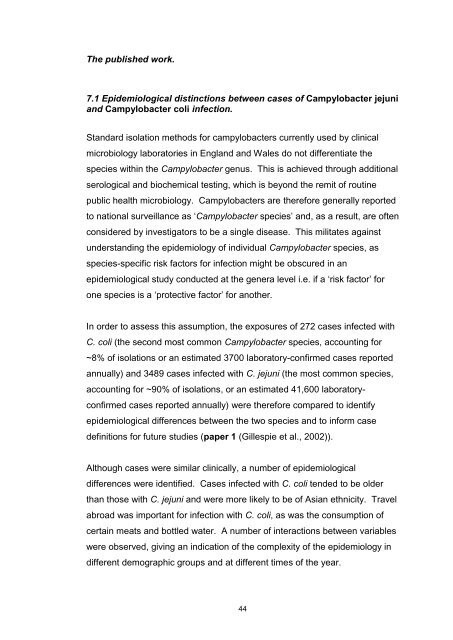PhD thesis - University of Hertfordshire Research Archive
PhD thesis - University of Hertfordshire Research Archive
PhD thesis - University of Hertfordshire Research Archive
You also want an ePaper? Increase the reach of your titles
YUMPU automatically turns print PDFs into web optimized ePapers that Google loves.
The published work.<br />
7.1 Epidemiological distinctions between cases <strong>of</strong> Campylobacter jejuni<br />
and Campylobacter coli infection.<br />
Standard isolation methods for campylobacters currently used by clinical<br />
microbiology laboratories in England and Wales do not differentiate the<br />
species within the Campylobacter genus. This is achieved through additional<br />
serological and biochemical testing, which is beyond the remit <strong>of</strong> routine<br />
public health microbiology. Campylobacters are therefore generally reported<br />
to national surveillance as „Campylobacter species‟ and, as a result, are <strong>of</strong>ten<br />
considered by investigators to be a single disease. This militates against<br />
understanding the epidemiology <strong>of</strong> individual Campylobacter species, as<br />
species-specific risk factors for infection might be obscured in an<br />
epidemiological study conducted at the genera level i.e. if a „risk factor‟ for<br />
one species is a „protective factor‟ for another.<br />
In order to assess this assumption, the exposures <strong>of</strong> 272 cases infected with<br />
C. coli (the second most common Campylobacter species, accounting for<br />
~8% <strong>of</strong> isolations or an estimated 3700 laboratory-confirmed cases reported<br />
annually) and 3489 cases infected with C. jejuni (the most common species,<br />
accounting for ~90% <strong>of</strong> isolations, or an estimated 41,600 laboratory-<br />
confirmed cases reported annually) were therefore compared to identify<br />
epidemiological differences between the two species and to inform case<br />
definitions for future studies (paper 1 (Gillespie et al., 2002)).<br />
Although cases were similar clinically, a number <strong>of</strong> epidemiological<br />
differences were identified. Cases infected with C. coli tended to be older<br />
than those with C. jejuni and were more likely to be <strong>of</strong> Asian ethnicity. Travel<br />
abroad was important for infection with C. coli, as was the consumption <strong>of</strong><br />
certain meats and bottled water. A number <strong>of</strong> interactions between variables<br />
were observed, giving an indication <strong>of</strong> the complexity <strong>of</strong> the epidemiology in<br />
different demographic groups and at different times <strong>of</strong> the year.<br />
44

















